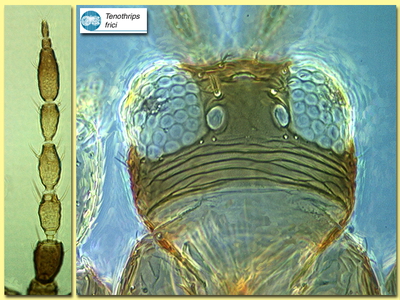Figures
Fig. 1 Antenna and head (dorsal)
Fig. 2 Head, thorax and abdomen
Fig. 3 Pronotum
Fig. 4 Fore and hind wing
Fig. 5 Meso- and metanotum
Fig. 6 Tergite VIII and IX (female)
Species
Tenothrips frici UzelBiology
Breeding commonly in flowers of Compositae.
Distribution
Widespread around the world in areas with a Mediterranean climate.
Recognition
Body and legs dark brown, tarsi and fore tibiae paler; antennal segments III-V and base of VI yellow; forewing uniformly dark; major setae dark. Head wider than long; with 3 pairs of ocellar setae, pair III arising lateral to ocellar triangle and equal in length to one side of the triangle. Antennae 8-segmented, III & IV with sense cone forked. Pronotum slightly wider at posterior than anterior, with 2 pairs of posteroangular setae. Metanotum median setae arising at anterior margin, sculpture forming characteristic arch-like lines at posterior margin. Forewing first vein with 3 setae on distal half, second vein with about 10 equally spaced setae. Tergites without paired ctenidia but with a few irregular microtrichia laterally; VIII posterior margin with a comb of irregular microtrichia laterally; X divided longitudinally. Sternites without discal setae. Male similar to female in structure but smaller and more slender; tergite IX with 4 equally spaced setae medially; sternites III-VII with broadly oval glandular area.
Related species
A further 12 Old World species are placed in this genus, all with restricted distributions.







